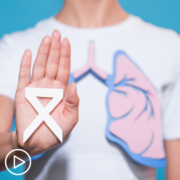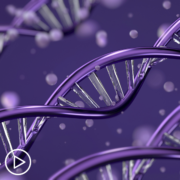Tag Archive for: Chemo
What Are Guidelines for Rising Myeloma Marker Levels?
What Are Guidelines for Rising Myeloma Marker Levels? from Patient Empowerment Network on Vimeo.
What are multiple myeloma guidelines for marker levels? Expert Dr. Sikander Ailawadhi from Mayo Clinic discusses marker levels that are checked and levels that could be concerning for disease progression.
Download Guide | Descargar Guía
See More from START HERE Myeloma
Related Programs:

|
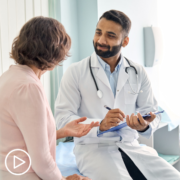
|

|
Transcript:
Lisa Hatfield:
This patient is asking, “My M spike keeps rising in spite of chemo. What can I do?”
Dr. Sikander Ailawadhi:
Very important question, Lisa. Every patient must understand what their disease marker is. This patient is asking about the M spike, which is the monoclonal spike, whether it’s in the blood or in the urine. And if the M spike is continuing to increase and there is a significant increase, significant is defined by at least 25 percent from the nadir or from the bottom most point with the, at least an absolute increase of 0.5 gram per deciliter. So half a gram per deciliter. So we want a 25 percent increase, but we also want at least 0.5 gram per deciliter.
So if somebody had an M spike of one at their best point, then the increase to 1.5 is significant. If somebody had the M spike of 0.2, then it’s not the 25 percent increase, it’s the 0.5 that must happen. So they hit 0.7 and that’s a significant increase. So that’s how we think about M spike, 25 percent with an absolute of at least 0.5 gram per deciliter.
If that is indeed happening, this would be considered a biochemical progression. And at that point, it should be considered to switch around the treatment because we don’t want the disease to grow to the point that there are actually symptoms showing up or organ damage happening. We want to be able to capture the disease progression sooner and act upon it.
Lisa Hatfield:
Do you have any recommendations for people who, as we might have some patients watching this, who are light chain only? Any guidelines on if those numbers are rising?
Dr. Sikander Ailawadhi:
That’s an excellent question too. So if somebody has light chains as their marker, we are looking at an increase in the involved serum free light chain. So if somebody has kappa as their marker, the kappa is going up, or if they have lambda as the marker, the lambda is going up. Typically, if both of them go up, that is not disease progression. That could be coming from kidney dysfunction. Somebody is dehydrated and they get labs checked. Both kappa and lambda might be elevated. Again, a 25 percent increase in the absolute. But at the same time, we are also looking at at least 10 milligram per deciliter change. So if somebody had a light chain of two milligram per deciliter, if it goes to 12, that might be a significant change. But I can say that light chains are a little bit more volatile and they do get affected by our fluid status. So if I ever notice a patient with a light chain increase, I’m more likely to repeat the test very soon, maybe even at a couple of days, one week interval, just to make sure that there is a trend rather than just a fluctuating light chain.
Lisa Hatfield:
Okay. Thank you for that information.
Dr. Sikander Ailawadhi:
And I should maybe, very quickly add, we do not check light chains in the urine. Light chains should be checked in the blood. Urine light chains are very nonspecific, and there’s no need to test them.
Share Your Feedback:
Create your own user feedback survey
Factors to Consider When Choosing a Gastric Cancer Treatment Approach
Factors to Consider When Choosing a Gastric Cancer Treatment Approach from Patient Empowerment Network on Vimeo.
What factors should be considered when choosing a gastric cancer treatment approach? Dr. Yelena Janjigian outlines key considerations that help determine the best treatment for an individual patient.
Dr. Yelena Janjigian is Chief of Gastrointestinal Oncology Service at Memorial Sloan Kettering Cancer Center.
See More From INSIST! Gastric Cancer
Related Programs:

|
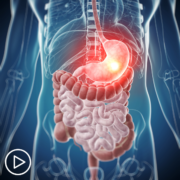
|

How Do Biomarker Test Results Impact Gastric Cancer Treatment Options? |
Transcript:
Katherine:
Are there other decision factors involved in deciding on treatment options? You mentioned age, comorbidities. What else do you look at?
Dr. Janjigian:
Yeah, the other important factor as I said is nutrition. Being able to stay fit and stay independent is very important. Some of my patients ask me, and then they feel like what they eat is so important that as soon as they get their diagnosis, they restrict their diet. And then they start losing weight. And that’s not good. The number one negative prognostic factor is if you lose more than 10 percent of your body weight within the first few months of the diagnosis – because you get really weak, and then you can’t tolerate the chemotherapy. So, I tell the patients, “Your body will take from you whatever it wants. The cancer will take from you, from your body. So, you need to support yourself nutritionally.” So, if you don’t feel like eating a salad, but you are craving a cookie, it’s okay.
Have that cookie; just don’t lose weight. And I think that’s the number one. And also, the other factor is how do you communicate your diagnosis and your prognosis to your family and your friends? Because then everybody’s asking and making you in some ways anxious, your job. And what I tell patients is, “It’s on need-to-know basis.” If you find love and support, then you can tell people.
Otherwise, you can just loosely kind of mention that you need some help, and you’re going through treatment without specific details. And the great part about these combination immunotherapies is that a lot of our functional patients actually continue to work through this. And so, we fill out whatever forms they need for their jobs and so forth. But we have lawyers that are continuing to work, teachers, and sometimes even construction workers. So, really, I would say make decisions as they come up.
Don’t run too far ahead and sort of assume that you’re going to not be well. But if you want to take some time off, that’s okay too. And so, I think the treatment paradigm for this disease has evolved so much that there’s a lot of misconceptions. And I think the job of a good oncologist is to let the patient live their life in as normal a fashion as possible.
So, we work the chemo schedules around their schedule. Some of these immunotherapies you can give once a month. So, I have patients who will fly into see me, for example, get the dose, and then go back home. So, I think don’t be afraid to ask for what you need.
BTK Inhibitor Treatment Side Effects | What CLL Patients Should Know
BTK Inhibitor Treatment Side Effects | What CLL Patients Should Know from Patient Empowerment Network on Vimeo.
What do chronic lymphocytic leukemia (CLL) patients need to know about BTK inhibitor treatment side effects? Expert Dr. Danielle Brander explains common side effects with BTK inhibitors.
Dr. Danielle Brander is an Assistant Professor in the Division of Hematologic Malignancies & Cellular Therapy at Duke University Medical Center. Learn more about Dr. Danielle Brander.
Download Resource Guide | Descargar Guía en Español
Related Programs:

|

|

|
Transcript:
Lisa Hatfield:
We have a couple of questions about BTK inhibitors, and you already talked a little bit about the role of those and why they’re significant in treating CLL. But another patient’s asking about the, of course, a lot of patients wonder, what are the side effects? They hear chemo and like, “Oh, my gosh, the side effects are going to be off.” Can you talk about the side effects and even maybe some unusual side effects that you’ve heard of from patients when using the BTK inhibitors?
Dr. Danielle Brander:
Sure, absolutely. And so again, really important, these are things that as we maybe anticipate patients are going to start treatment, this is a long discussion of deciding between treatment, for example, as first treatment. There’s no trial saying one path is necessarily better than the other. So we try to individualize choosing between BTK inhibitors or that venetoclax-based therapy I mentioned. Some of that though comes about and what expected side effects are expected side effects for the individual. I try for patients to hear it from myself, other members of the team, the nurse, our pharmacist, for example.
And so patients shouldn’t feel overwhelmed to keep asking about what to expect or new side effects. There are some side effects we talk about regardless of the treatment. So I’ll just point out, anytime you’re starting treatment, you’ll hear the team talk about risk for infection, monitoring for fevers, reaching out to us about those kinds of side effects, lower blood counts that can happen regardless, not specific to BTK though it can happen there as well.
There’s some specifically though with BTK inhibitors, we ask patients to watch out for. Some BTK inhibitors can cause some cardiovascular side effects, meaning watching out for funny beating of the heart or what we call palpitations, skipped beats. There can be arrhythmias, some patients can have with time elevation in their blood pressure, for example. And then risk for bleeding, meaning BTK inhibitors affect how the platelets stick together similar to what aspirin does.
So the platelet levels may be normal but patients might have easier bruising, just generally manageable. But if there’s any kind of bleeding, certainly the team should be aware. It’s also the reason though, if you’re on a BTK inhibitor and you have a planned surgery or procedure, let your team know, because we may recommend or a lot of times recommend holding the medication before and after certain surgeries or procedures.
Other side effects can be muscle or joint aches. Some patients have some gastrointestinal side effects like looser stools or sensitivities to certain food causing looser stools, for example. And then there are some that are specific to the individual BTK inhibitor. This is the one point I’ll mention that first-generation BTK inhibitor ibrutinib, part of the reason for the second-generation zanubrutinib (Brukinsa) and acalabrutinib (Calquence) is not necessarily of them working better but to have less of these side effects that I just mentioned.
Share Your Feedback
Create your own user feedback survey
Can Vaccines Play a Role in Preventing or Helping to Treat Lung Cancer?
Can Vaccines Play a Role in Preventing or Helping to Treat Lung Cancer? from Patient Empowerment Network on Vimeo.
What’s the latest in lung cancer research and treatment updates? Expert Dr. Lecia Sequist shares information about emerging research currently under study, new treatments that have shown success, and her perspective about second opinions for patient care.
Dr. Sequist is program director of Cancer Early Detection & Diagnostics at Massachusetts General Hospital and also The Landry Family Professor of Medicine at Harvard Medical School.
[ACT]IVATION TIP:
“…ask your doctor if they think a second opinion could be helpful.”
Download Resource Guide en español
See More from [ACT]IVATED NSCLC
Related Resources:
Transcript:
Lisa Hatfield.
Dr. Sequist, fortunately, the lung cancer arsenal keeps expanding. What promising treatments do you see on the horizon or that are newly available to lung cancer patients?
Dr. Lecia Sequist:
Yeah. The field is changing so fast, it almost makes your head spin. And I think it’s wonderful that there are so many options. It’s actually been a challenge for the doctors to keep on top of the latest treatments, because they’ve been coming out so fast, especially over the last five years.
And some of the things that I’m personally excited about in lung cancer is that there may soon be an opportunity to think about vaccines that could help prevent or could help treat lung cancers. That’s something that scientists are working on that aren’t available, but it does look like it’s realistic, that it could happen. Some of the technologies that helped develop, for example, the COVID vaccine in such a short period of time might be available to personalize treatment against an individual’s tumor. So my vaccine, if I got cancer, could be different than your vaccine if you got cancer, because they’re kind of personalized.
There’s also a new type of treatment called antibody drug conjugates, which are a smarter way of delivering chemotherapy. We’ve always just given chemotherapy to the whole body, usually through a vein, through an intravenous in the arm, and it drips in and it circulates around with the bloodstream. And the good thing about that is that it can go everywhere. So if there’s a cancer cell that’s hiding somewhere too small to be seen on the scan, the chemotherapy can get there. But it does, there’s a lot of collateral damage from toxicities from delivering chemo where there is no cancer. And with these antibody drug conjugates, the idea is that there’s an antibody in the front that’s honing into some kind of target on the cancer cell. And it still goes in through the IV, but when it reaches a cancer cell and attaches, then the backend sort of drops a bomb, which is a chemotherapy on that area.
So instead of the chemo being given to the whole body, every time the front end of this thing hits cancer cells, it engages and that triggers the backend, which is the chemotherapy kind of bomb to be dropped. So there are a lot of these types of drugs where it’s more like targeted delivery of chemo. Some of them have already been approved for cancers like breast cancer, but we don’t have an approved antibody drug conjugate in lung cancer yet. But there are a couple that are moving towards potential FDA approval. So I think given how complicated the new treatments are, my activation tip for patients would be to ask your doctor if they think a second opinion could be helpful. And I think a lot of patients feel that that might be rude or their doctor might not react in a positive way to them saying, do you think I should get a second opinion?
But as a physician, I can tell you that it’s not taken that way by most doctors. And in fact, a lot of oncologists will even suggest to their patients, you know, “Hey, this is a complicated area. I would love to get input from my colleague. I’m going to send you to a city nearby for a second opinion.” We all rely on our colleagues a lot, and not everybody can know everything about every cancer, especially with how quickly things are changing. So second opinions are not a sign that you don’t trust your doctor or you don’t like your doctor. It’s just a sign that you really want more input. The more minds, the more brains that are thinking about your cancer, the better. And don’t be afraid to ask your doctor if they think a second opinion could be helpful for your case.
Share Your Feedback:
Create your own user feedback survey
What Does Breast Cancer Hormone Receptor Status Mean?
What Does Breast Cancer Hormone Receptor Status Mean? from Patient Empowerment Network on Vimeo.
There are many subclassifications of breast cancer—including a patient’s hormone receptor status. Expert Dr. Jame Abraham defines hormone receptor status and explains the potential impact on breast cancer treatment outcomes.
Dr. Jame Abraham is the chairman of the Department of Hematology & Medical Oncology at Cleveland Clinic and professor of medicine at Cleveland Clinic Lerner College of Medicine. Learn more about Dr. Abraham.
See More From INSIST! Breast Cancer
Related Resources:
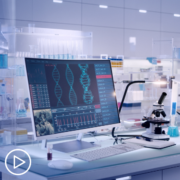
How Do Genomic Testing Results Impact Breast Cancer Treatment Options? |
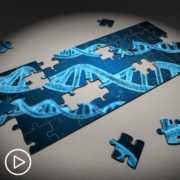
|
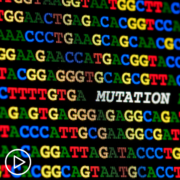
|
Transcript:
Katherine:
Dr. Abraham, can you please explain hormone receptor status?
Dr. Abraham:
Yeah. So, as you know, really well, breast cancer is not one disease. It can be five, or six, or seven different diseases. There are so many subclassifications for breast cancer. So, most common type of breast cancer, especially if I can see, in postmenopausal patients, almost 70 percent of breast cancers are postmenopausal. Sorry, you can edit that out. So, in postmenopausal patients, 70 percent of breast cancers are hormone-positive, or estrogen receptor-positive – 70 percent is estrogen receptor-positive.
So, what that means is, when, after the biopsy, the tumor is sent for a test.
In that test, the pathologist will say – they’ll stain the tumor, and then, see if the tumor has a receptor, which is estrogen receptor, and progesterone receptor. So, as I said, 70 percent, it’s actually hormone-positive. When the tumor is estrogen receptor-positive, overall, prognosis is better. So, our prognosis is better. Second, we have better treatments, which can target that estrogen receptor-positive tumor. So, it’s a good thing when patients have hormone receptor-positive disease. Prognosis is better, we have better treatments.
How Do Genomic Testing Results Impact Breast Cancer Treatment Options?
How Do Genomic Testing Results Impact Breast Cancer Treatment Options? from Patient Empowerment Network on Vimeo.
Understanding a breast cancer patient’s individual disease is vital to personalizing their care. Dr. Jame Abraham explains how genomic testing results could impact a patient’s treatment path.
Dr. Jame Abraham is the chairman of the Department of Hematology & Medical Oncology at Cleveland Clinic and professor of medicine at Cleveland Clinic Lerner College of Medicine. Learn more about Dr. Abraham.
See More From INSIST! Breast Cancer
Related Resources:
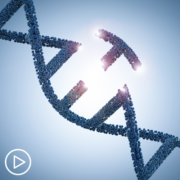
What’s the Difference Between Germline and Somatic Breast Cancer Mutations? |

|

|
Transcript:
Katherine:
Dr. Abraham, how do genomic test results impact treatment options?
Dr. Abraham:
So, let’s just kind of think about the germline mutation. Let’s just say, we do a genetic testing for a patient with a stage two breast cancer. And let’s just say, if the patient has BRCA1 mutation, basically, we are saying, if somebody has a BRCA1 mutation, there’s about a 20 to 40 percent chance of developing contralateral breast cancer, breast cancer on the other side, and then, about 20 to 40 percent chance of developing ovarian cancer.
So, if I’m seeing somebody who is in their 40s or 50s, those who completed their family, completed the family, then, with the mutation, we will talk to them about potential risk reduction surgeries for the other breast.
And then, in addition, we’ll talk about removing the ovaries for prevention of ovarian cancer.
So, that’s one major decision point. And then, let’s just say, with the BRCA mutation, there are new drugs, FDA-approved, what we call as, PARP inhibitors, or olaparib (Lynparza). After completing their chemotherapy and other treatments, we can add a PARP inhibitor or olaparib to their adjuvant treatment. That means, after surgery and chemo, we can add this medicine, for their treatment, for a year.
So, this has tremendous implications for their treatment. And then, let’s just say, if she has other family members, there’s about 50 percent chance that they may have the same.
So, you can probably talk to them about doing the testing for them, and that may influence their screening methods, to see if she has kids, and what 50 percent chance that they can inherit this gene. Again, that can influence how we screen and manage them.
So, let’s just say, if I’m seeing somebody who stage I breast cancer, you’re positive, and then, we do a genomic testing. It’s not exactly somatic, but it’s, still, it’s a genomic testing.
So, we do a genomic testing, such as Oncotype, or MammaPrint – so, again, that’s an early-stage breast cancer – that specifically looked at certain things within the tumor, which are markers for proliferation. So, those tests will help us, again, in a specific subset of patients, ER-positive, HER2-negative, early-stage patients, tests, such as Oncotype and MammaPrint, will help us to identify who will need chemo, or whom we can spare more aggressive treatments like chemo.
And then, in metastatic setting, when we do this testing, we can see certain mutations within the tumor that will allow us to recommend treatments based upon that.
What Is a Breast Cancer Genetic Mutation?
What Is a Breast Cancer Genetic Mutation? from Patient Empowerment Network on Vimeo.
Breast cancer patients may learn that they have a “genetic mutation”—so what does that mean exactly? Dr. Jame Abraham defines the term and explains what mutation status could reveal about a patient’s individual disease.
Dr. Jame Abraham is the chairman of the Department of Hematology & Medical Oncology at Cleveland Clinic and professor of medicine at Cleveland Clinic Lerner College of Medicine. Learn more about Dr. Abraham.
See More From INSIST! Breast Cancer
Related Resources:
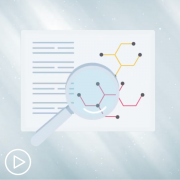
What Do You Need to Know About Breast Cancer Genetic Testing? |

What’s the Difference Between Germline and Somatic Breast Cancer Mutations? |

|
Transcript:
Dr. Abraham:
So, genetic mutation is, the change is happening within the tumor, which is making it more aggressive, or less aggressive. So, what’s driving this tumor? Let us think, it’s like a machine, and the machine has, probably, different parts, and we know, every part plays a role in driving that engine, but some part may be playing a major role in driving that engine, and the question is, can we knock that off with certain medicine?
So, select genetic testing. If the tumor has, what we call, it’s an ESR1 mutation, then we can use some medicine, which can block that ESR1. That’s a new drug, which just got approved recently, to see if they have some kind of an immune marker, what we call as, a PD-L1 marker. Then, it can be used like an immunotherapy, to stop that cell growth. So, let’s just say, if I have somebody with BRCA1 somatic mutation, in some patients, even certain medicines, like PARP inhibitors, may be helpful. So, identifying that, what’s turning them on, and trying to identify a medicine which can turn that off.
What’s the Difference Between Germline and Somatic Breast Cancer Mutations?
What’s the Difference Between Germline and Somatic Breast Cancer Mutations? from Patient Empowerment Network on Vimeo.
Breast cancer expert Dr. Jame Abraham reviews the key differences between germline and somatic genomic testing and explains the role they play in treatment, care, and predicting a recurrence.
Dr. Jame Abraham is the chairman of the Department of Hematology & Medical Oncology at Cleveland Clinic and professor of medicine at Cleveland Clinic Lerner College of Medicine. Learn more about Dr. Abraham.
See More From INSIST! Metastatic Breast Cancer
Related Resources:

What Do You Need to Know About Breast Cancer Genetic Testing? |

|

|
Transcript:
Katherine:
Dr. Abraham, what’s the difference between germline and somatic genetic mutations?
Dr. Abraham:
Sure. So, germline, as I said, to see if we carry that gene, and it means, I’m born with that. I’m inherited. I carry that gene. That’s in my DNA. Somatic is, the change is happening within the tumor, within the tumor.
So, it’s kind of – sometimes, it can be acquired. So, let’s just say, if I’m seeing a patient with breast cancer, and then, it can be early stage. So, I’ll kind of say that – let’s just say, if I’m seeing somebody with a stage II breast cancer, we can do a genomic testing of the tumor to identify the risk of recurrence for the next nine years or so. We do that, mainly in what we call as ER-positive, HER2-negative tumors. So, hormone-positive, HER2-negative tumors.
In early-stage setting, we do genomic testing to classify the risk of recurrence. And I found the high risk, or low risk, that’s one. And second, this genomic testing will tell us the benefit from chemotherapy.
So, share prognosis, and treatment decision.
So, the other genomic testing we commonly do is, let’s just say, she has seen somebody who is metastatic, means the cancer already spread to other part of the body. Again, we can do the genomic testing from the tumor, and then, that’ll kind of give us what, the changes happening within the tumor. That’ll help us to identify potential, and what particular targets within the tumor, so that we can treat them with new treatments, or screen them for clinical trials.
And then, some of the new treatments have specific mutations that’ll identify if patients benefit from certain medications. So, the genomic testing will help us to select patients for these new treatments, or even clinical trials.


